A Two-Stage Fuzzy Optimization Model for Urban Land Use: A Case Study of Chongzhou City
Abstract
:1. Introduction
2. Methodology
2.1. Two-Stage Land Use Optimization Model
2.1.1. Bayesian Network for Land Use
2.1.2. Land Use Optimization Mathematical Programming Model
- (1)
- Environmental constraints
- (2)
- Economic constraints
- (3)
- Social constraints
- (4)
- Programming constraint
- (5)
- Other Constraints
- (6)
- Carbon effect estimation
2.1.3. Cellular Automata Simulation
3. Case Study
4. Results and Discussion
4.1. Influencing Factors of Land Use: Bayesian Network
4.2. Comparative Analysis of Influence Factors
4.3. Affect Probability Distribution
4.4. Optimization Analysis of Land Use Structure
4.5. Behavior Rule Validation
5. Discussion
6. Conclusions
Author Contributions
Funding
Institutional Review Board Statement
Informed Consent Statement
Data Availability Statement
Conflicts of Interest
References
- Verstegen, J.A.; Karssenberg, D.; van der Hilst, F.; Faaij, A. Spatio-temporal uncertainty in Spatial Decision Support Systems: A case study of changing land availability for bioenergy crops in Mozambique. Comput. Environ. Urban Syst. 2012, 36, 30–42. [Google Scholar] [CrossRef] [Green Version]
- Jiang, S.; Meng, J.J.; Zhu, L.K.; Cheng, H.R. Spatial-temporal pattern of land use conflict in China and its multilevel driving mechanisms. Sci. Total Environ. 2021, 801, 149697. [Google Scholar] [CrossRef]
- Liang, X.; Guan, Q.F.; Clarke, K.C.; Liu, S.S.; Wang, B.Y.; Yao, Y. Understanding the drivers of sustainable land expansion using a patch-generating land use simulation (PLUS) model: A case study in Wuhan, China. Comput. Environ. Urban Syst. 2021, 85, 101569. [Google Scholar] [CrossRef]
- Zhou, Y.; Li, X.H.; Liu, Y.S. Land use change and driving factors in rural China during the period 1995–2015. Land Use Policy 2020, 99, 105048. [Google Scholar] [CrossRef]
- Alexander, P.; Prestele, R.; Verburg, P.H.; Arneth, A.; Baranzelli, C.; Batista e Silva, F.; Brown, C.; Butler, A.; Calvin, K.; Dendoncker, N.; et al. Assessing uncertainties in land cover projections. Glob. Chang. Biol. 2017, 23, 767–781. [Google Scholar] [CrossRef] [PubMed] [Green Version]
- Grebitus, C.; Steiner, B.; Veeman, M. The roles of human values and generalized trust on stated preferences when food is labeled with environmental footprints: Insights from Germany. Food Policy 2015, 52, 84–91. [Google Scholar] [CrossRef] [Green Version]
- Gao, P.P.; Li, Y.P.; Gong, J.W.; Huang, G.H. Urban land-use planning under multi-uncertainty and multiobjective considering ecosystem service value and economic benefit—A case study of Guangzhou, China. Ecol. Complex. 2021, 45, 100886. [Google Scholar] [CrossRef]
- Ma, S.H.; Wen, Z.Z. Optimization of land use structure to balance economic benefits and ecosystem services under uncertainties: A case study in Wuhan, China. J. Clean. Prod. 2021, 311, 127537. [Google Scholar] [CrossRef]
- Hersperger, A.M.; Oliveira, E.; Pagliarin, S.; Palka, G.; Verburg, P.; Bolliger, J.; Grădinaru, S. Urban land-use change: The role of strategic spatial planning. Glob. Environ. Chang. 2018, 51, 32–42. [Google Scholar] [CrossRef]
- Harvey, D. Space as a Keyword; Blackwell Publishing Ltd.: Hoboken, NJ, USA, 2008. [Google Scholar]
- Van der Hilst, F.; Verstegen, J.A.; Karssenberg, D.; Faaij, A.P.C. Spatiotemporal land use modelling to assess land availability for energy crops—Illustrated for Mozambique. Glob. Chang. Biol. Bioenergy 2012, 4, 859–874. [Google Scholar] [CrossRef]
- Meyer, S.R.; Johnson, M.L.; Lilieholm, R.J.; Cronan, C.S. Development of a stakeholder-driven spatial modeling framework for strategic landscape planning using Bayesian networks across two urban-rural gradients in Maine, USA. Ecol. Model. 2014, 291, 42–57. [Google Scholar] [CrossRef] [Green Version]
- Chuai, X.W.; Huang, X.J.; Wang, W.J.; Zhao, R.Q.; Zhang, M.; Wu, C.Y. Land use, total carbon emission’s change and low carbon land management in Coastal Jiangsu, China. J. Clean. Prod. 2015, 103, 77–86. [Google Scholar] [CrossRef]
- Han, D.; Qiao, R.L.; Ma, X.M. Optimization of Land-Use Structure Based on the Trade-Off Between Carbon Emission Targets and Economic Development in Shenzhen, China. Sustainability 2019, 11, 11. [Google Scholar] [CrossRef] [Green Version]
- Xue, M.G.; Ma, S.H. Optimized Land-Use Scheme Based on Ecosystem Service Value: Case Study of Taiyuan, China. J. Urban Plan. Dev. 2018, 144, 04018016. [Google Scholar] [CrossRef]
- Feng, Y.; Yang, Q.; Cui, L.; Liu, Y. Simulation and Prediction of Urban Land Use Change with Spatial Autoregressive Model Based Cellular Automata. Geogr. Geo-Inf. Sci. 2016, 32, 37–44. [Google Scholar]
- Pedrielli, G.; Matta, A.; Alfieri, A.; Zhang, M.Y. Design and control of manufacturing systems: A discrete event optimisation methodology. Int. J. Prod. Res. 2018, 56, 543–564. [Google Scholar] [CrossRef]
- Resat, H.G.; Turkay, M. A bi-objective model for design and analysis of sustainable intermodal transportation systems: A case study of Turkey. Int. J. Prod. Res. 2019, 57, 6146–6161. [Google Scholar] [CrossRef]
- Du, G.; Zhang, Y.Y.; Liu, X.J.; Jiao, R.J.; Xia, Y.; Li, Y. A review of leader-follower joint optimization problems and mathematical models for product design and development. Int. J. Adv. Manuf. Technol. 2019, 103, 3405–3424. [Google Scholar] [CrossRef]
- Xu, X.; Wu, Z.; Lin, Q.; Xie, L. Models on the topological optimization of crop mixing planting. Syst. Sci. Compr. Stud. Agric. 2003, 19, 63–65, 70. [Google Scholar]
- Wang, F.; Zhou, B.; Xu, J. Land suitability spatial analysis and optimal exploitation pattern in tidal flat. Trans. Chin. Soc. Agric. Eng. 2008, 24, 119–123. [Google Scholar]
- Zhang, H.-B.; Zhang, X.-H. Land use structural optimization of Lilin based on GMOP-ESV. Trans. Nonferr. Met. Soc. China 2011, 21, S738–S742. [Google Scholar] [CrossRef]
- Sun, J.; Li, Y.P.; Suo, C.; Liu, Y.R. Impacts of irrigation efficiency on agricultural water-land nexus system management under multiple uncertainties—A case study in Amu Darya River basin, Central Asia. Agric. Water Manag. 2019, 216, 76–88. [Google Scholar] [CrossRef]
- Ren, C.; Li, Z.; Zhang, H. Integrated multi-objective stochastic fuzzy programming and AHP method for agricultural water and land optimization allocation under multiple uncertainties. J. Clean. Prod. 2019, 210, 12–24. [Google Scholar] [CrossRef]
- Ou, G.; Tan, S.; Zhou, M.; Lu, S.; Tao, Y.; Zhang, Z.; Zhang, L.; Yan, D.; Guan, X.; Wu, G. An interval chance-constrained fuzzy modeling approach for supporting land-use planning and eco-environment planning at a watershed level. J. Environ. Manag. 2017, 204, 651–666. [Google Scholar] [CrossRef] [PubMed]
- Ma, S.; Xue, M.; Zhou, H. A method for planning regional ecosystem sustainability under multiple uncertainties: A case study for Wuhan, China. J. Clean. Prod. 2019, 210, 1545–1561. [Google Scholar] [CrossRef]
- Bhuiyan, T.H.; Moseley, M.C.; Medal, H.R.; Rashidi, E.; Grala, R.K. A stochastic programming model with endogenous uncertainty for incentivizing fuel reduction treatment under uncertain landowner behavior. Eur. J. Oper. Res. 2019, 277, 699–718. [Google Scholar] [CrossRef]
- Miç, P.; Koyuncu, M.; Hallak, J. Primary Health Care Center (PHCC) Location-Allocation with Multi-Objective Modelling: A Case Study in Idleb, Syria. Int. J. Environ. Res. Public Health 2019, 16, 811. [Google Scholar] [CrossRef] [Green Version]
- Türk, E.; Zwick, P.D. Optimization of land use decisions using binary integer programming: The case of Hillsborough County, Florida, USA. J. Environ. Manag. 2019, 235, 240–249. [Google Scholar] [CrossRef]
- Ouattara, P.D.; Kouassi, E.; Egbendewe, A.Y.G.; Akinkugbe, O. Risk aversion and land allocation between annual and perennial crops in semisubsistence farming: A stochastic optimization approach. Agric. Econ. 2019, 50, 329–339. [Google Scholar] [CrossRef]
- Rodias, E.C.; Lampridi, M.; Sopegno, A.; Berruto, R.; Banias, G.; Bochtis, D.D.; Busato, P. Optimal energy performance on allocating energy crops. Biosyst. Eng. 2019, 181, 11–27. [Google Scholar] [CrossRef]
- Santé-Riveira, I.; Crecente-Maseda, R.; Miranda-Barrós, D. GIS-based planning support system for rural land-use allocation. Comput. Electron. Agric. 2008, 63, 257–273. [Google Scholar] [CrossRef]
- Aljanabi, A.A.; Mays, W.L.; Fox, P. Optimization Model for Agricultural Reclaimed Water Allocation Using Mixed-Integer Nonlinear Programming. Water 2018, 10, 1291. [Google Scholar] [CrossRef] [Green Version]
- Hocaoğlu, M.F. Weapon target assignment optimization for land based multi-air defense systems: A goal programming approach. Comput. Ind. Eng. 2019, 128, 681–689. [Google Scholar] [CrossRef]
- Nie, Y.; Avraamidou, S.; Xiao, X.; Pistikopoulos, E.N.; Li, J.; Zeng, Y.; Song, F.; Yu, J.; Zhu, M. A Food-Energy-Water Nexus approach for land use optimization. Sci. Total Environ. 2019, 659, 7–19. [Google Scholar] [CrossRef] [Green Version]
- Lin, B.Q.; Zhu, J.P. Impact of China’s new-type urbanization on energy intensity: A city-level analysis. Energy Econ. 2021, 99, 11. [Google Scholar] [CrossRef]
- Howes, A.L.; Maron, M.; McAlpine, C.A. Bayesian Networks and Adaptive Management of Wildlife Habitat. Conserv. Biol. 2010, 24, 974–983. [Google Scholar] [CrossRef]
- Mitraka, Z.; Doxani, G.; Frate, F.D.; Chrysoulakis, N. Uncertainty Estimation of Local-Scale Land Surface Temperature Products Over Urban Areas Using Monte Carlo Simulations. IEEE Geosci. Remote Sens. Lett. 2016, 13, 917–921. [Google Scholar] [CrossRef]
- Chen, S.H.; Pollino, C.A. Good practice in Bayesian network modelling. Environ. Model. Softw. 2012, 37, 134–145. [Google Scholar] [CrossRef]
- Liu, Y.; Martin, M.; Liu, Y.; He, J. Landuse change model based on cellar automata of decision-making with grey situation. Remote Sens. 2004, 5232, 575–586. [Google Scholar]
- Shouzhang, P. 1-km Monthly Precipitation Dataset for China (1901–2017); National Tibetan Plateau Data Center: Beijing, China, 2020. [Google Scholar]
- Peng, S.; Ding, Y.; Liu, W.; Li, Z. 1 km monthly temperature and precipitation dataset for China from 1901 to 2017. Earth Syst. Sci. Data 2019, 11, 1931–1946. [Google Scholar] [CrossRef] [Green Version]
- Song, R.; Zhu, J.; Hou, P.; Wang, H. Getting Every Ton of Emissions Right: An Analysis of Emission Factors for Purchased Electricity in China; World Resources Institute: Beijing, China, 2013. [Google Scholar]
- Zhang, C.; Zhong, L.J.; Fu, X.T.; Wang, J.; Wu, Z.X. Revealing Water Stress by the Thermal Power Industry in China Based on a High Spatial Resolution Water Withdrawal and Consumption Inventory. Environ. Sci. Technol. 2016, 50, 1642–1652. [Google Scholar] [CrossRef] [PubMed]
- Chavez, A.; Ramaswami, A. Articulating a trans-boundary infrastructure supply chain greenhouse gas emission footprint for cities: Mathematical relationships and policy relevance. Energy Policy 2013, 54, 376–384. [Google Scholar] [CrossRef] [Green Version]
- Liu, Z.; Davis, S.J.; Feng, K.; Hubacek, K.; Liang, S.; Anadon, L.D.; Chen, B.; Liu, J.; Yan, J.; Guan, D. Targeted opportunities to address the climate–trade dilemma in China. Nat. Clim. Chang. 2016, 6, 201–206. [Google Scholar] [CrossRef]
- Papadopoulos, C.E.; Yeung, H. Uncertainty estimation and Monte Carlo simulation method. Flow Meas. Instrum. 2002, 12, 291–298. [Google Scholar] [CrossRef]

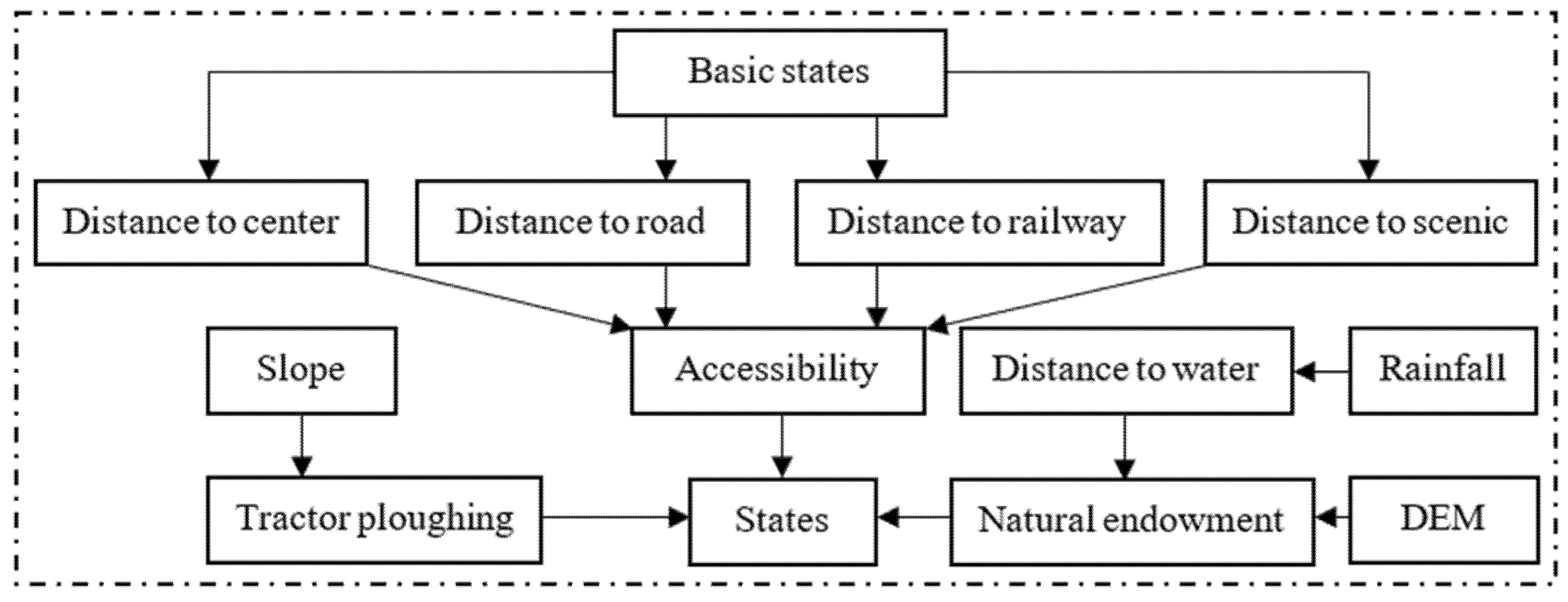

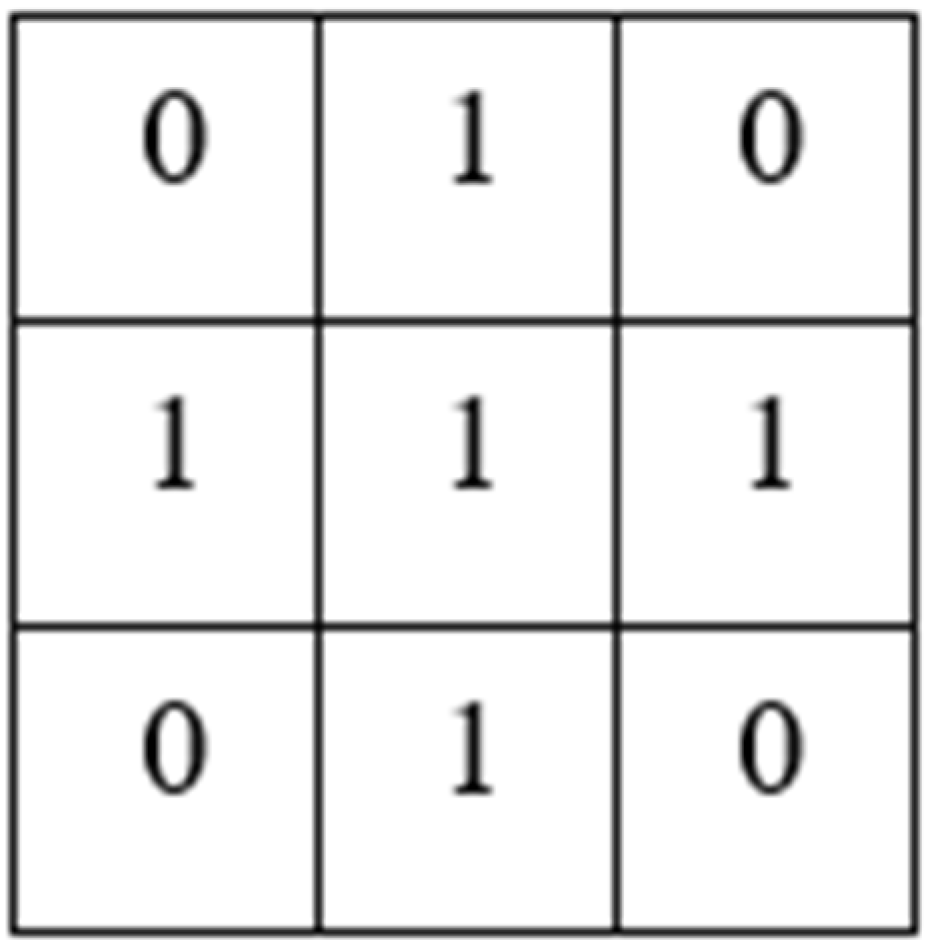

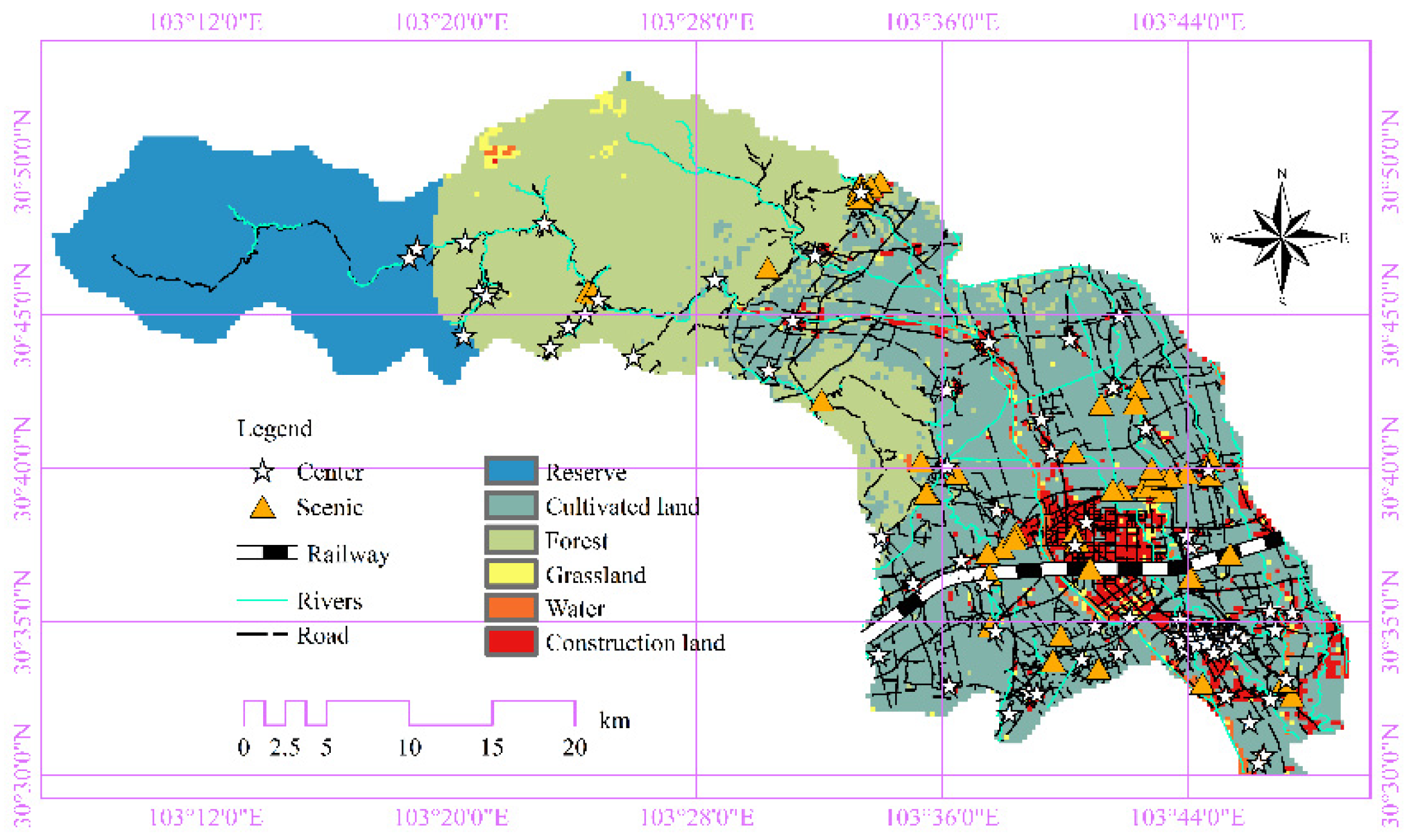
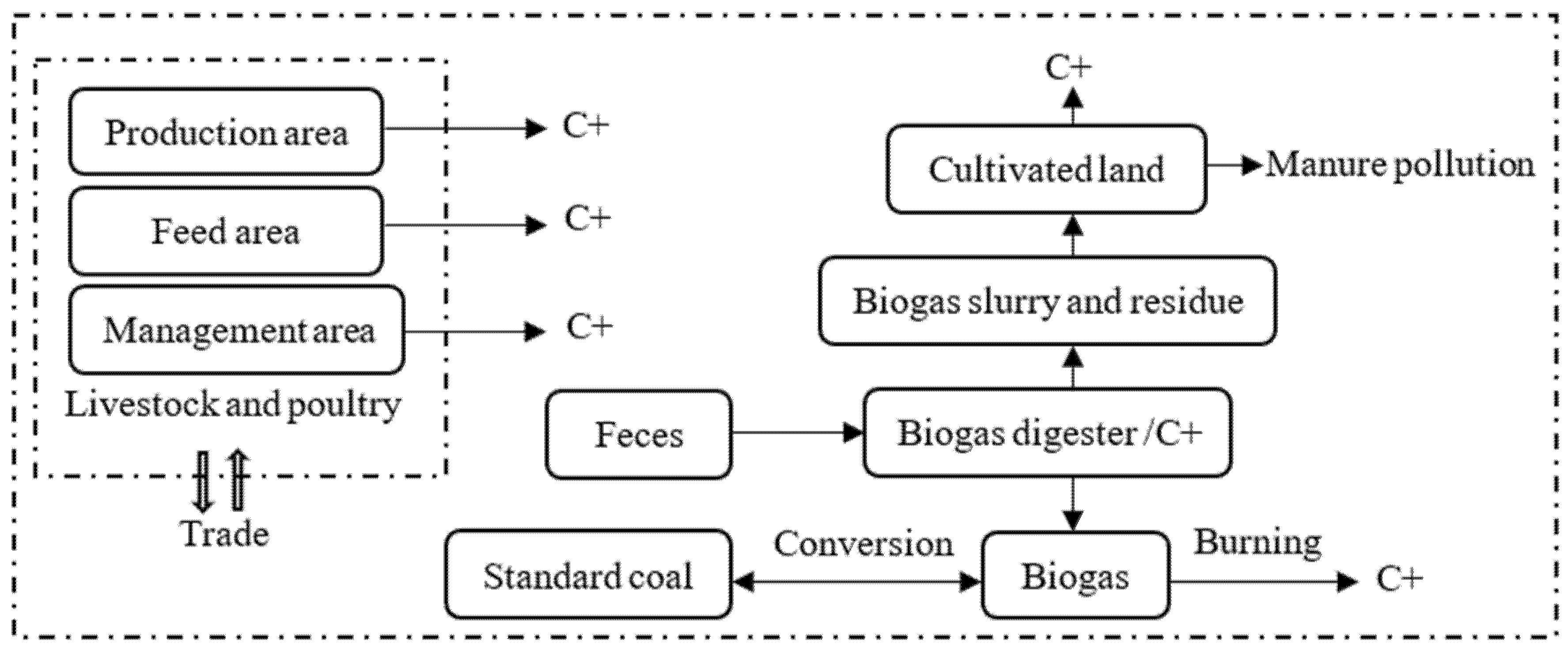
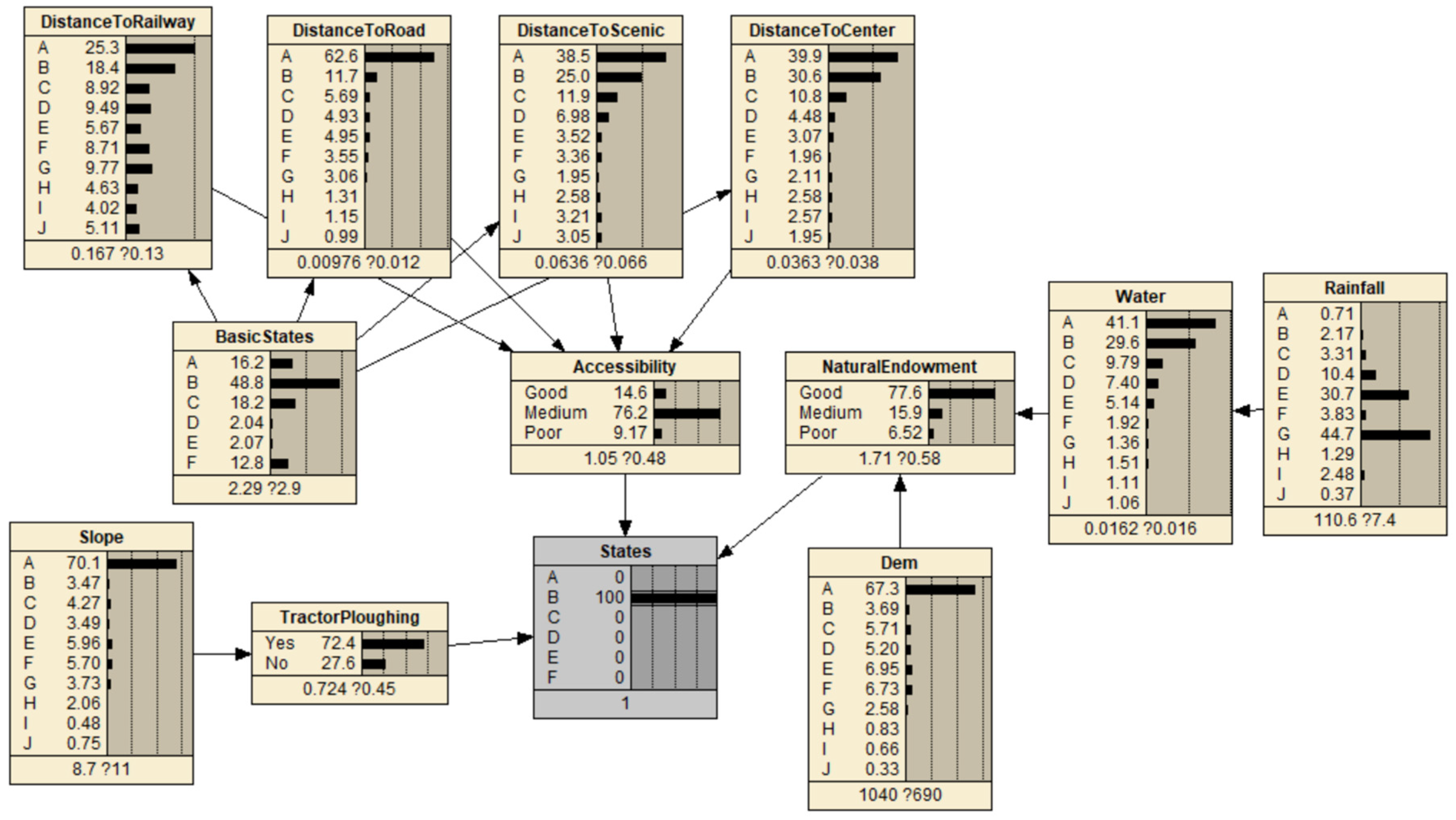
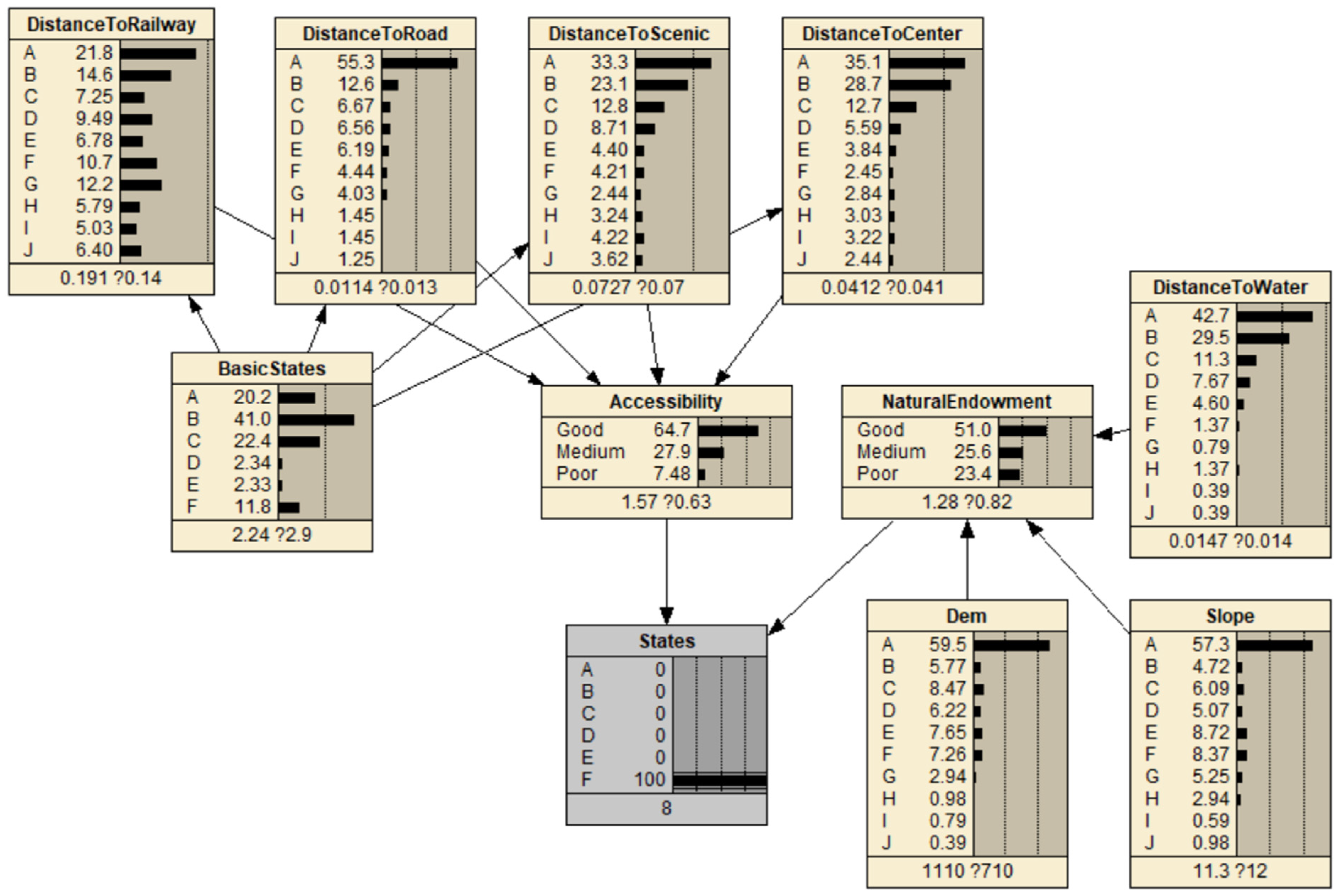
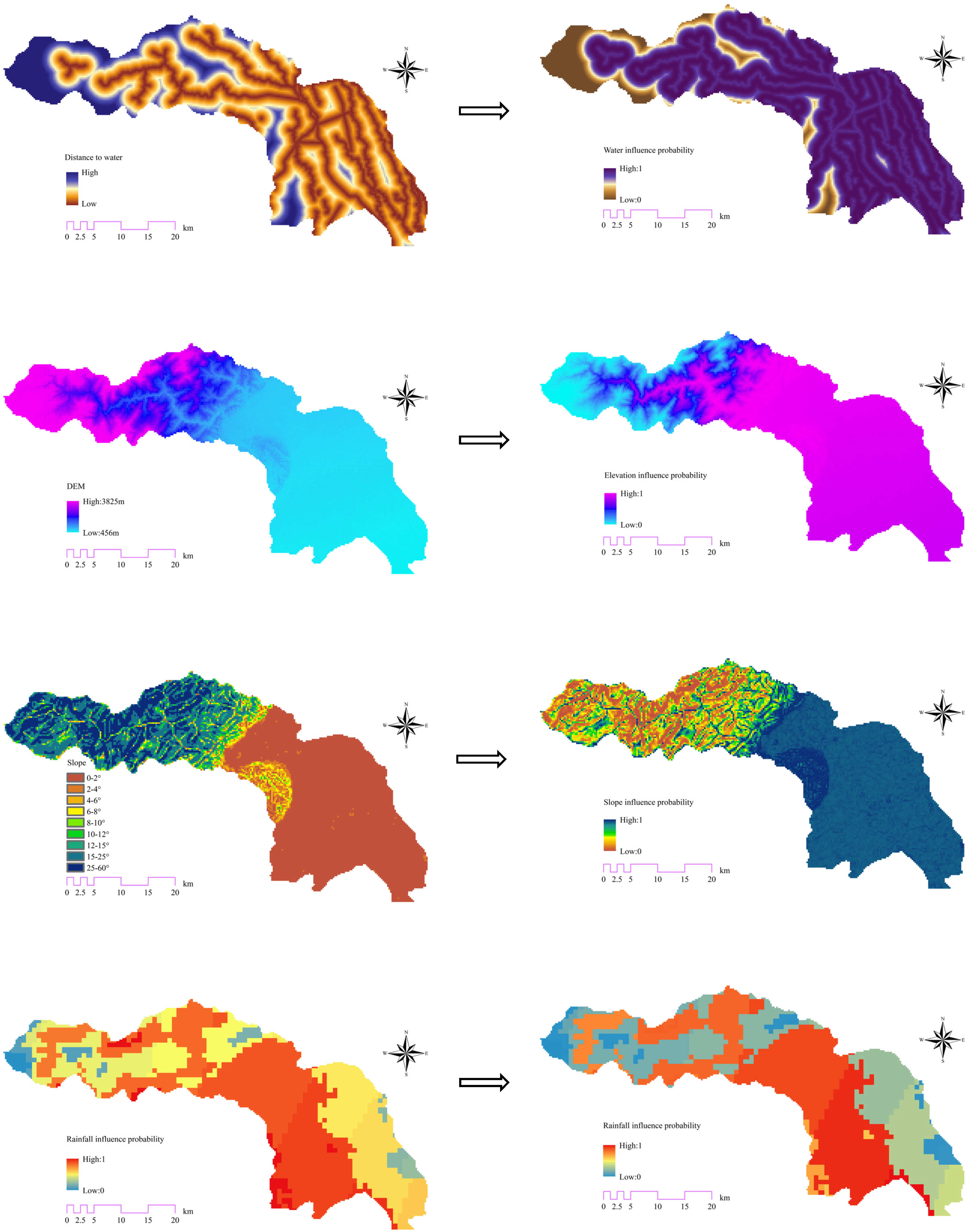
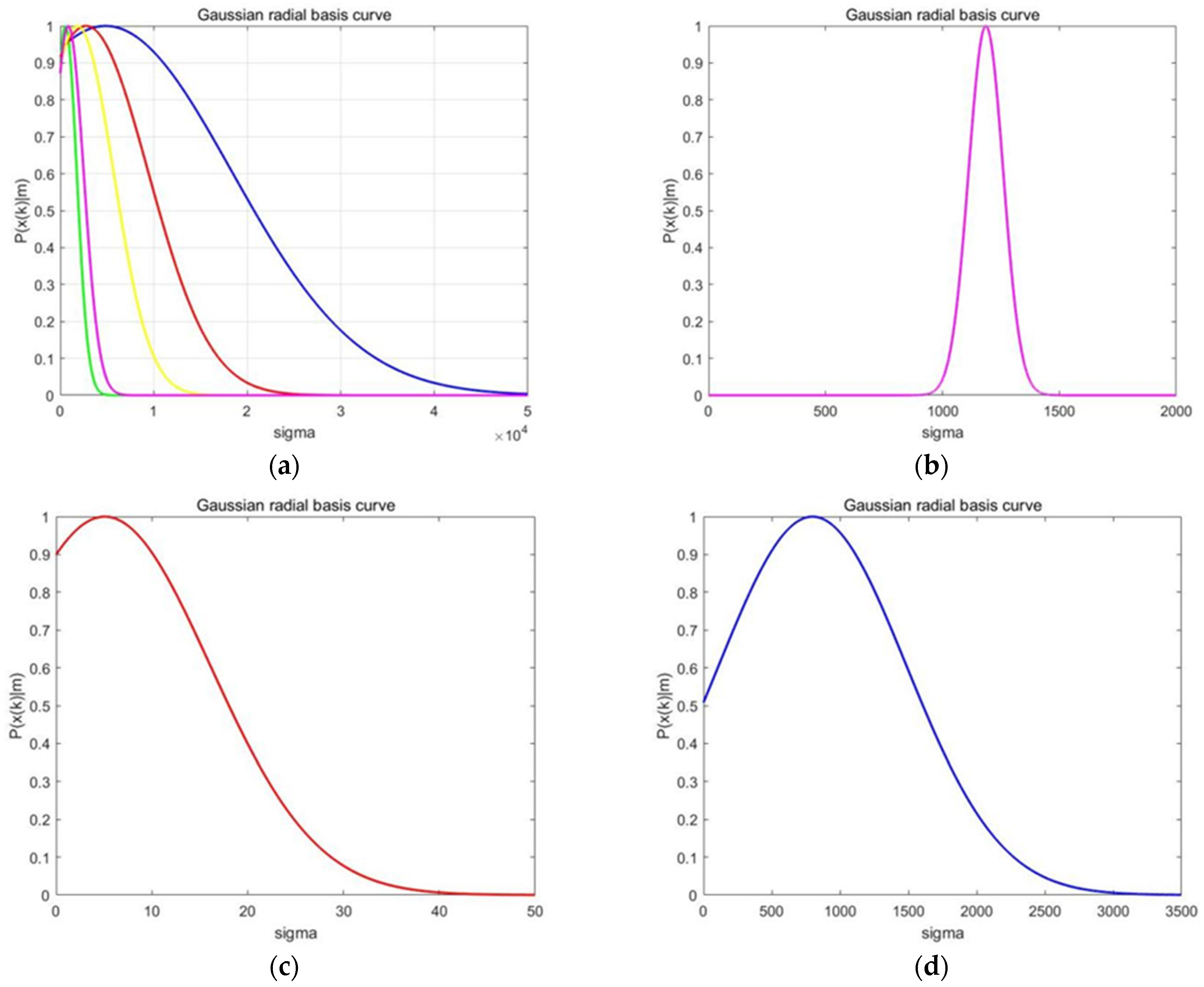

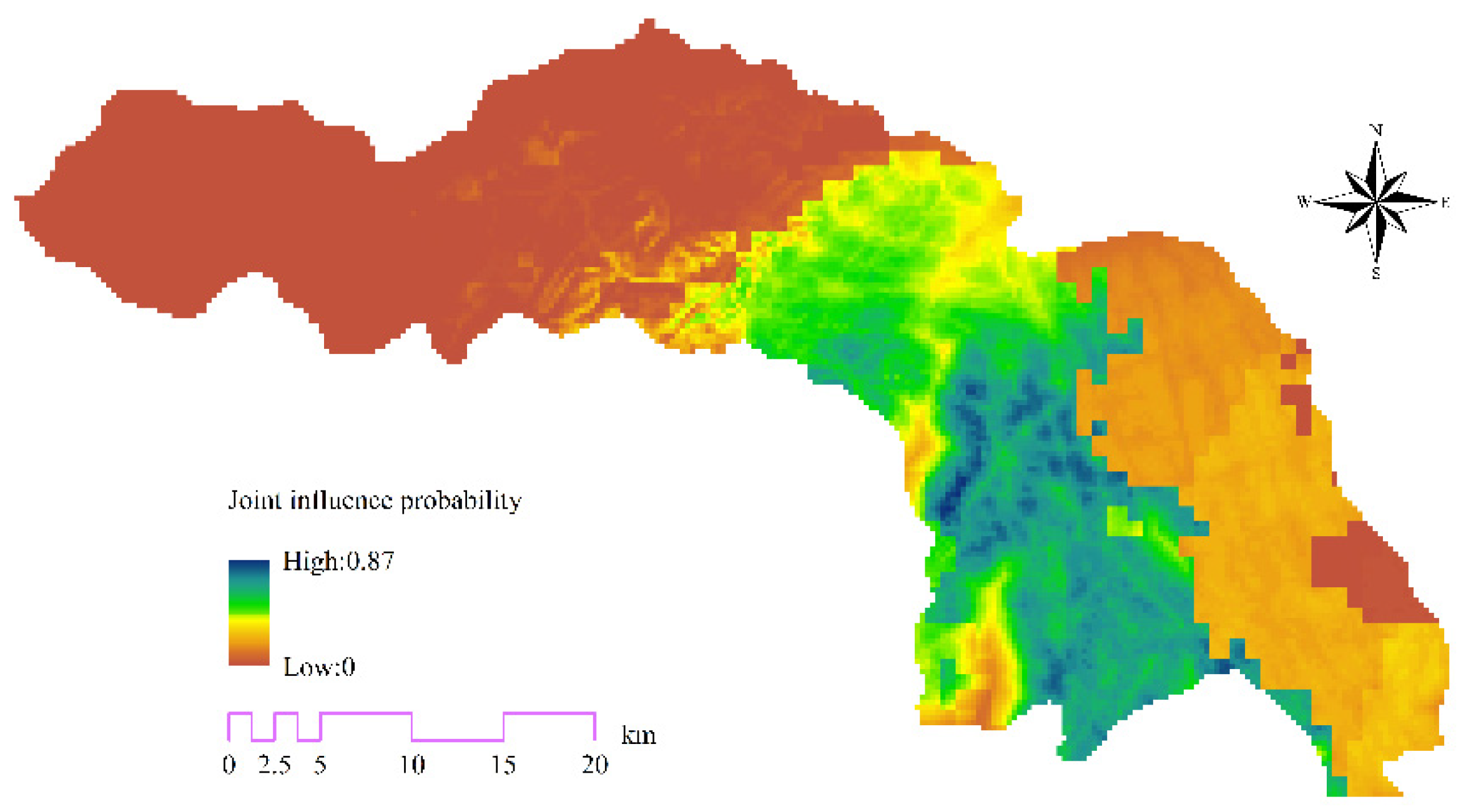

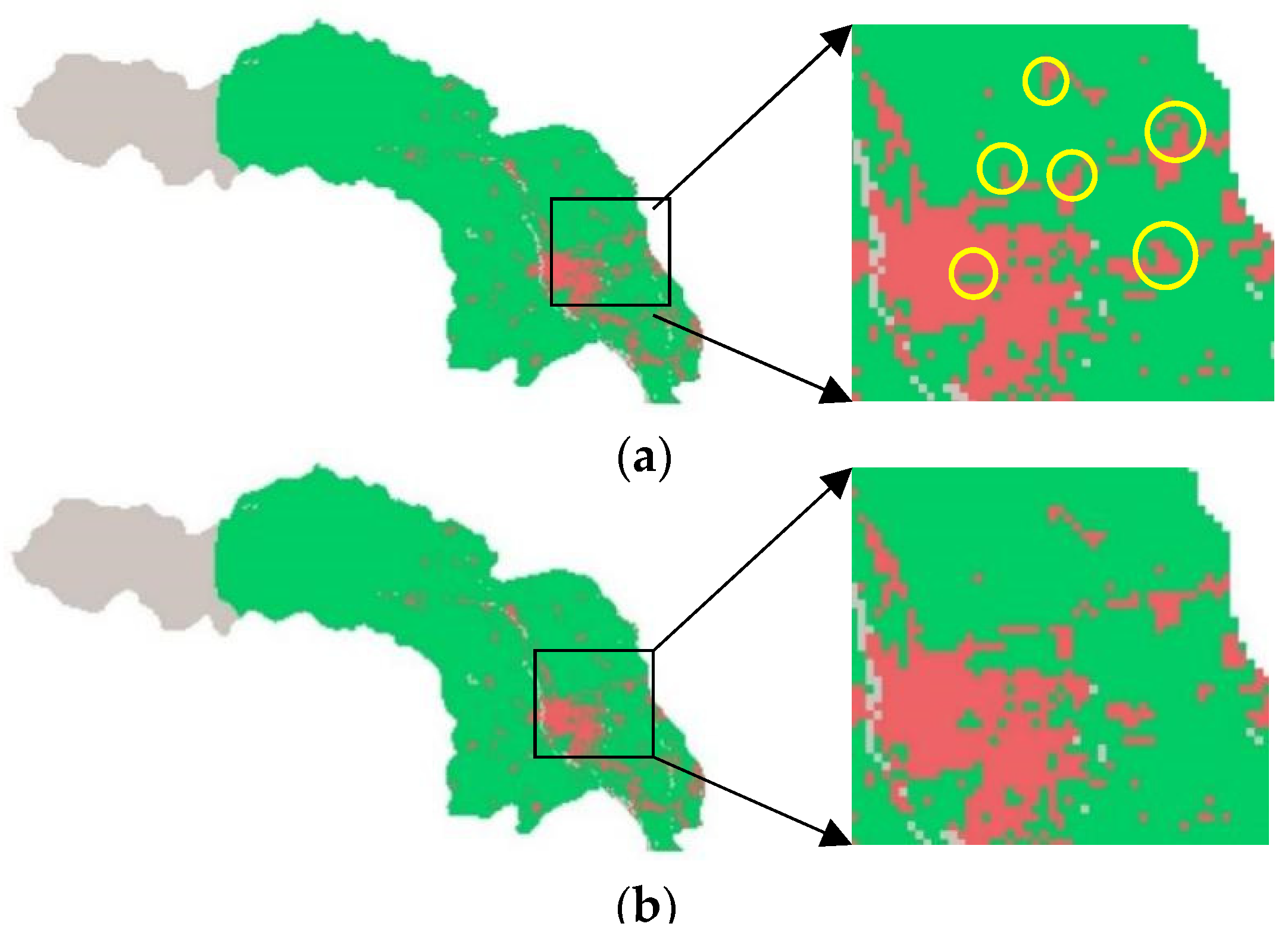
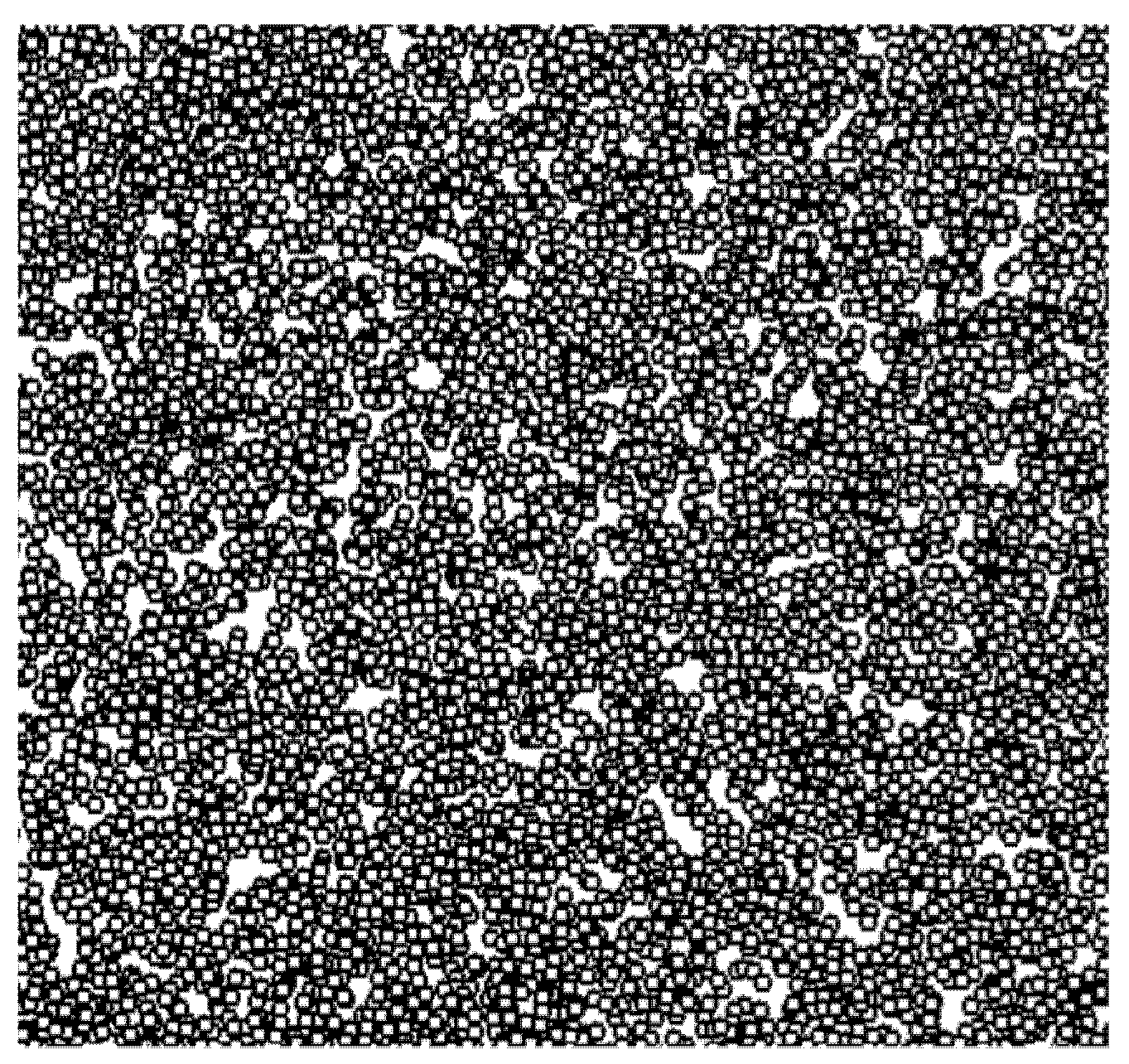
| Constraint Type | Constraint Parameters | Unit | Value |
|---|---|---|---|
| Environmental parameters | Soil erosion rate | % | 2 |
| Erodible area | km2 | 8 | |
| Cultivated wastewater per unit area | kg/km2 | 6.48 × 106 | |
| Municipal wastewater per unit area | kg/km2 | 18.91 × 106 | |
| Total capacity of wastewater treatment | kg/year | [1 × 1010, 1.2 × 1010] | |
| Solid waste per unit area | kg/km2 | 58.39 × 103 | |
| Total capacity of solid waste treatment | kg | [7 × 107, 7.3 × 107] | |
| Economic parameters | Unit farmland fixed assets investment | yuan/km2 | 4.16 × 106 |
| Unit urban fixed assets investment | yuan/km2 | 4.01 × 108 | |
| Import investment | yuan | 6.84 × 108 | |
| Export investment | yuan | 0 | |
| Total investment | yuan | [2.93 × 1010, 3 × 1010] | |
| Social parameters | Unit grain output | kg/km2 | 2.51 × 105 |
| Total grain demand | kg | [8.97 × 107, 9 × 107] | |
| Unit cultivated labor | people/km2 | 251 | |
| Unit urban labor force | people/km2 | 6 312 | |
| Total labor force | people | [5.42 × 105, 6.65 × 105] | |
| Planning parameters | Cultivated land protection red line | km2 | 338 |
| Limits on the scale of construction land | km2 | 70 | |
| Non-negative restriction | km2 | 0 |
| Objection Parameters | Unit | Value |
|---|---|---|
| Economic benefits per unit of land area | yuan/km2 | 8.60 × 106 |
| yuan/km2 | 4.41 × 108 | |
| Carbon emissions from farmland wastewater treatment | kg/km2 | 6.80 × 103 |
| Carbon emissions from municipal wastewater treatment | kg/km2 | 19.85 × 103 |
| Carbon emissions from solid waste disposal | kg/km2 | 62.28 × 103 |
| Carbon emissions from livestock and poultry production | kg | 9.59 × 107 |
| Carbon emissions from people ploughing land | kg/km2 | 19.85 × 103 |
| Carbon emissions from urban construction land | kg/km2 | 498.68 × 103 |
| Carbon emissions from energy use on cultivated land | kg/km2 | 1.07 × 103 |
| Carbon emissions from urban energy use | kg/km2 | 2.89 × 106 |
Publisher’s Note: MDPI stays neutral with regard to jurisdictional claims in published maps and institutional affiliations. |
© 2021 by the authors. Licensee MDPI, Basel, Switzerland. This article is an open access article distributed under the terms and conditions of the Creative Commons Attribution (CC BY) license (https://creativecommons.org/licenses/by/4.0/).
Share and Cite
Yao, J.; Qiu, B.; Zhou, M.; Deng, A.; Li, S. A Two-Stage Fuzzy Optimization Model for Urban Land Use: A Case Study of Chongzhou City. Sustainability 2021, 13, 13961. https://doi.org/10.3390/su132413961
Yao J, Qiu B, Zhou M, Deng A, Li S. A Two-Stage Fuzzy Optimization Model for Urban Land Use: A Case Study of Chongzhou City. Sustainability. 2021; 13(24):13961. https://doi.org/10.3390/su132413961
Chicago/Turabian StyleYao, Jinjiang, Bingkui Qiu, Min Zhou, Aiping Deng, and Siqi Li. 2021. "A Two-Stage Fuzzy Optimization Model for Urban Land Use: A Case Study of Chongzhou City" Sustainability 13, no. 24: 13961. https://doi.org/10.3390/su132413961
APA StyleYao, J., Qiu, B., Zhou, M., Deng, A., & Li, S. (2021). A Two-Stage Fuzzy Optimization Model for Urban Land Use: A Case Study of Chongzhou City. Sustainability, 13(24), 13961. https://doi.org/10.3390/su132413961






